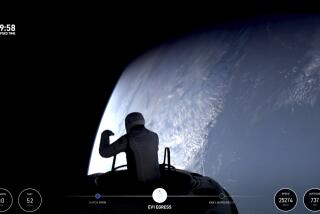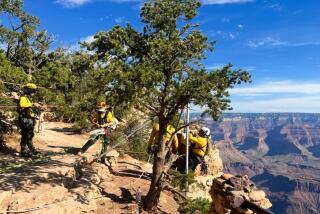Daredevil went faster than previously thought during 24-mile fall
The results are in from Felix Baumgartner’s record-setting leap from a capsule floating more than 24 miles above a barren New Mexico desert, and it turns out he went faster during his supersonic free fall than originally estimated.
With more than 8 million computers and other digital devices tuned in Oct. 14 to the live stream on YouTube, Baumgartner reached 843.6 mph, or 1.25 times the speed of sound. Previous estimates said he hit speeds of nearly 834 mph.
Either way, he was the first free-falling human to crack the sound barrier.
PHOTOS: Daredevil breaks world record with highest fall
Baumgartner, 43, also set a record for the highest-altitude manned balloon flight at 127,852 feet -- 248 feet lower than previously estimated, according to the official numbers released Tuesday.
Mission officials said the records were finalized after a science team conducted a review at the California Science Center on Jan. 23.
The 75-page review included a team of professionals made up of NASA astronauts, U.S. Air Force officers and representatives from Southern California aerospace companies, such as Virgin Galactic, Northrop Grumman Corp., XCOR Aerospace Inc. and Space Exploration Technologies Corp., or SpaceX.
There is interest among the companies as they look for answers to the problem of crew and passenger escape in emergency situations with commercial space travel on the horizon, mission officials said. In particular, the companies want answers about the limits and capabilities of the human body bailing out from aircraft at ultra-high altitudes.
When Baumgartner stepped into the stratosphere from his capsule, he was supersonic within 34 seconds into the free-fall, the study said.
Baumgartner, a trained Austrian sky diver, had a heart rate of 176 beats per minute at the time of jump. A normal resting heart rate for adults ranges from 60 to 100 beats a minute.
He began wildly spinning as he descended at high speeds. Officials had feared a “flat spin” -- a horizontal spin that can lead to a loss of consciousness.
The spinning was apparent even in a live video shot taken by a long-range camera. But Baumgartner righted himself.
The final results found that Baumgartner had a flat spin exposure of about 13 seconds. He also had 25.2 seconds of absolute weightlessness during initial free fall.
“It feels like you are floating into space, and then you pick up speed very fast -- but you don’t feel the air because the air density is so low,” Baumgartner said in a statement. “For almost 35 seconds I couldn’t sense the air around me because basically there was none.”
After free falling 119,431 feet, Baumgartner pulled the rip cord and sent his red and white parachute streaming into the sky. The shock of opening the parachute was measured at 3.27 times the force of gravity.
Before the feat, there had been concerns about how a human body might respond to supersonic speeds without the benefit of an aircraft. But at a post-event news conference, Baumgartner said he didn’t know when he sped through the sound barrier. “I didn’t feel it at all,” he said.
Upon landing, he fell to his knees and raised his fists before being enveloped by personnel involved in the mission.
The jump was an endeavor, five years in the making, to break a free-fall world record of 102,800 feet, or 19 miles, set by Air Force test pilot Joe Kittinger in 1960. Kittinger, now 84, was part of the new mission and relayed messages between the control room and Baumgartner.
Baumgartner’s jump was funded by energy drink company Red Bull, which paid millions of dollars to Southern California aerospace companies to pull off the stunt, but wouldn’t say exactly how much. The event was named Red Bull Stratos.
ALSO:
Boeing asks FAA for OK to begin 787 Dreamliner test flights
British troops use mini-drones to find targets on the battlefield
Sea Launch mission fails; rocket, Intelsat satellite crash in ocean
More to Read
Sign up for Essential California
The most important California stories and recommendations in your inbox every morning.
You may occasionally receive promotional content from the Los Angeles Times.











